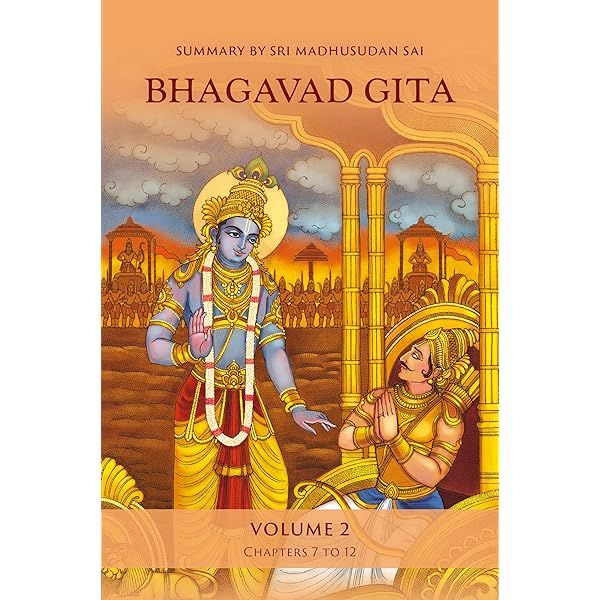Chapter II ‑The Bhagavad-Gita
byChapter II begins with Arjuna standing at the heart of battle, torn between duty and emotion. The battlefield is not just a place of war—it becomes a space where Arjuna’s soul confronts its deepest fears. Seeing his elders, mentors, and relatives on both sides, he is paralyzed by sorrow and doubts. Arjuna lowers his bow and declares he would rather live humbly than achieve victory soaked in the blood of those he loves. This moment is not one of cowardice but a crisis of conscience, reflecting the human tendency to hesitate when personal emotions clash with moral responsibility. Through this emotional breakdown, Arjuna raises timeless questions about duty, loss, and the meaning of righteousness. His vulnerability reveals the confusion many feel when caught between what the heart feels and what life demands.
Krishna responds not with immediate instruction but by shifting Arjuna’s perception from the personal to the eternal. He speaks of the soul as unchanging and indestructible, untouched by fire, water, weapons, or death. The body may perish, but the self that witnesses it continues beyond time. In reminding Arjuna of this, Krishna lifts the conversation to a higher truth—that fear and grief come from identifying with the temporary. The wise do not mourn the death of the body, knowing it is simply a change of form. Krishna explains that as people move from childhood to youth to old age, so does the soul move from one body to another. This continuity assures Arjuna that no true harm comes to the eternal self, and thus, duty must be carried out without emotional entanglement.
Action, Krishna emphasizes, is not to be avoided but must be performed with the right attitude. A warrior like Arjuna cannot abandon his role without causing confusion in the world. Each individual has a place in the cosmic order, and fulfilling that role is sacred. What matters is not the outcome but the intention and awareness behind the action. This gives rise to the principle of Nishkama Karma—acting without craving the fruits of the action. Such detachment frees the mind from anxiety and aligns it with peace. Krishna teaches that when actions are done with surrender to the divine will and without selfish motives, the soul grows in clarity and liberation. The goal is not to become passive, but to act with strength, humility, and non-attachment.
Krishna further criticizes the narrow-minded focus on ritual and rewards found in certain scriptural interpretations. People clinging to outcomes often get trapped in cycles of pleasure and pain, success and failure. True wisdom lies in transcending these opposites and realizing that happiness rooted in results is fragile. The steady mind, unaffected by gain or loss, becomes a vessel for higher awareness. One must rise above the fleeting to touch the eternal. Krishna warns that obsession with sensory pleasures dulls judgment and leads to restlessness. But when the senses are mastered and desire is quieted, the mind settles into stillness and insight. This is the essence of Yoga—not twisting the body, but calming the mind.
A person who walks the path of Yoga lives in the world but remains unshaken by its ups and downs. Krishna describes such a person as content within, not driven by external cravings or disturbed by change. This inner independence is born of self-realization and steady discipline. The yogi neither rejoices in pleasure nor grieves in sorrow but sees both as waves on the surface of a deeper truth. Through focused meditation and clarity of thought, the practitioner becomes free from longing. They walk through life with lightness, unattached yet fully present. This spiritual maturity brings calm not through escape, but through deep understanding.
As Arjuna listens, the battlefield becomes less about war and more about awakening. Krishna is not only calling Arjuna to fight but to see beyond the moment and grasp the eternal law that upholds the world. Dharma, or righteous duty, is not about blind obedience but conscious alignment with divine order. Arjuna is urged to move beyond personal grief and stand for something greater than himself. This moment becomes the turning point where confusion begins to shift toward wisdom. Krishna shows that true strength lies in clarity, not in emotionless action, but in action guided by eternal truth.
This chapter lays the philosophical bedrock for the rest of the Gita. It teaches that inner peace is not found by avoiding life, but by entering it with awareness and detachment. By focusing on what can be controlled—intention, attitude, discipline—the soul is lifted above the turmoil of the world. Arjuna’s struggle becomes a mirror for every human being who has ever hesitated in the face of responsibility. In responding to his doubt, Krishna provides a timeless framework for acting in the world without being bound by it.

